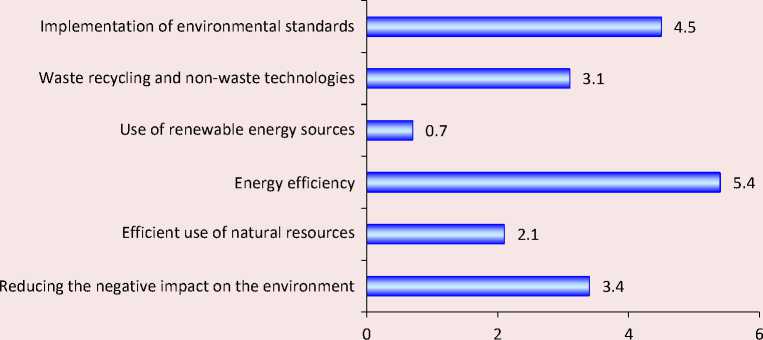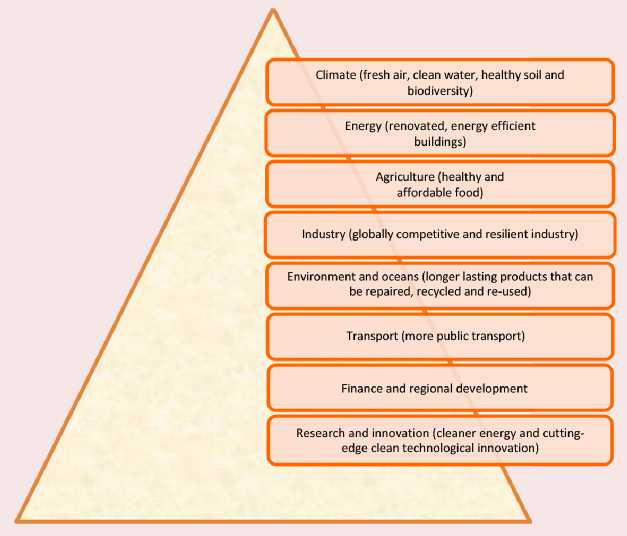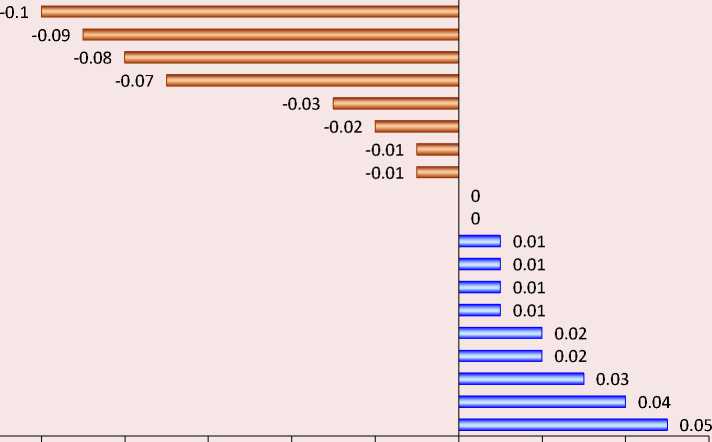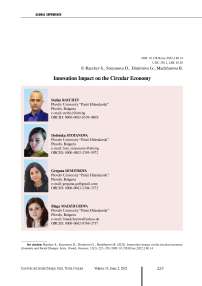Innovation impact on the circular economy
Автор: Raychev Stefan, Stoyanova Dobrinka, Dimitrova Gergana, Madzhurova Blaga
Журнал: Economic and Social Changes: Facts, Trends, Forecast @volnc-esc-en
Рубрика: Global experience
Статья в выпуске: 2 т.15, 2022 года.
Бесплатный доступ
The paper presents the arguments and counterarguments used in the scientific discussion on the issue of how innovations affect the circular economy and whether it changes accordingly. The main purpose is to analyze the extent to which EU member states manage to boost the circular economy through investment and employment. Review of literary sources and approaches for solving the problem of the multilateral and two-way impact of innovation on the circular economy indicates that the green economy could not exist without the development of innovation, but on the other hand they are its engine. Environmental practices show that there is a need to develop new business models taking into account functionally related innovative changes. The research methods and methodology covers the period from 2008 to 2018. The paper presents the results of an empirical analysis examining the extent to which EU member states manage to boost the circular economy through investment and employment, which showed that measures to increase their economic activity should be in line with the policy of attracting of investment in the circular economy. The research empirically confirms and proves that there still exist certain problems hindering the full implementation of the circular economy; and they are due to the consciousness of the population and employment opportunities in these areas, despite the efforts of the responsible institutions. The results of the research can be useful for public institutions dealing with the circular economy, as well as for the business sector.
Green economy, green innovations, labor market, business models
Короткий адрес: https://sciup.org/147237717
IDR: 147237717 | УДК: 338.1 | DOI: 10.15838/esc.2022.2.80.14
Текст научной статьи Innovation impact on the circular economy
The world and Europe are not the same anymore after the all-encompassing crisis they have been submerged into. Alongside the many negative effects, the possibility of a green innovative recovery has come to the fore, which will significantly increase the resilience of economies and societies in the face of a severe recession and accelerating environmental challenges. There is a problem which indicates that “while a number of countries are focusing on measures which can boost sustainability while stimulating jobs, income and growth, a few countries are proposing measures which support environmentally harmful activities”1. However, green fiscal spending may lead to stronger economic returns than traditional ones (O’Callaghan, Murdock, 2021). In addition, studies show that well-designed green spending can counteract environmental crises caused by climate change, pollution and biodiversity loss, while providing significant social benefits (Hepburn et al., 2020). Traditionally, the focus of green innovation has been put on minimizing the negative environmental impacts of production and consumer activities (e.g. pollution control technologies, vehicle catalysts). However, they are not enough to address most of the global sustainability challenges. The focus falls now on green innovations with demonstrable business benefits, including cost savings (for example, by improving material and energy efficiency) and new markets (e.g. green products and servicebased business models). The scale and urgency of societal challenges call for combinations of different innovations, including wider and faster implementation of tested green technologies, as well as new forms of flexible systemic innovations such as circular economy business models or integrated approaches to mobility.
The circular economy as a model of production and consumption which minimizes waste is a key part of the philosophy of sustainable development and the green economy as a whole. The promotion of the methods and elements of the circular economy is vital not only for the enhancement of the economic activity but also in response to the need to define the place and role of labor in a period of fundamental social and economic change in the context of globalization, the Fourth Industrial Revolution, climate change, etc. In support of the transition to a circular economy in 2015 the European Commission adopted the first action plan towards a circular economy. It includes measures to support Europe’s transition to a circular economy, increase global competitiveness, to promote sustainable economic growth and create new jobs. In 2020, the European Commission published its new Circular Economy Action Plan in support of the European Green Treaty. “ To achieve climate-neutrality by 2050, to preserve our natural environment, and to strengthen our economic competitiveness, requires a fully circular economy ”, said Frans Timmermans, the Commission’s vice president in charge of overseeing the European Green Deal2.
The results of the foreground analysis show that the European economy is largely still linear, as only 12% of materials being recycled and returned to the economy. One of the reasons for this is that most of the products are made for single use only and reuse is impossible.
This calls for a rethinking of the way products are produced and is set as a target in the Commission’s New Circular Economy Action Plan3.
All this emphasizes the importance of innovation (and green innovation in particular) and entrepreneurship (environmental, bio- and green entrepreneurship).
The proposed methodology for deriving the link between policies to promote the transition to a circular economy and the level of investment (gross investment as% of GDP) and green employment (number of employees as a percentage of total employment) is among the scientific contributions of the article.
The practical contribution aspects can be outlined in the context of approbation of the proposed methodology (on the example of the EU and considered three sectors of the circular economy). This forms trends, barriers and challenges, on the basis of which to assess the problem areas hindering the transition to a circular economy.
Theoretical review
The contribution of entrepreneurship and its impact on the economic growth, competitiveness and the achievement of sustainable development of national economies are indisputable, and its potential is realized through the creation, construction and implementation (commercialization) of innovations. Schumpeter sees innovation as a novelty which transforms reality and introduces the term “ creative destruction ”, in which existing products and production methods are destroyed and replaced with new ones (Schumpeter, 1934).
Innovation is already seen as a leading competitive advantage (Chiou et al., 2011; Kengatharan, 2012; Yosifov, 2019) and critical success factor for the business organizations to achieve sustainable economic development (Nacu, Avasilcai, 2014).
The ongoing climate change, scarce resources and increasing consumption (and production), as well as the emerging modern environmental challenges: pollution and environmental protection, “high consumption of materials, water and energy” (Fatoki, 2019) lead to the corresponding socioeconomic changes (Angelova, Pastarmadzhieva, 2020). This necessitates their evaluation, the “greening of the economic activities” (Taylor, Walley, 2004) and the focus on “green entrepreneurship” (Packiyanathan, Pushpanathan, 2021), also known as “eco-entrepreneurship” (Schaper, 2002; Schaper, 2016; Chell, 2008), “bioentrepreneurship” (Angelova, Pastarmadzhieva, 2020). It is considered as a type of social entrepreneurship, in the context of the so shaped “social aspect of sustainability, relationships and cultural cooperation” (Packiyanathan, Pushpanathan, 2021).
In 2020, the European Green Deal5 was launched as a new growth strategy with the aim of integrating environmental sustainability into the strategic goals for sustainable growth and competitiveness of the EU member states (Fig. 1). The pact sets out the two main priorities for growth: the green economy and the digital economy, as well as a comprehensive set of actions aimed at knowledge generation, research and innovation, partnerships, synergies, clustering, bioeconomy, digitalization, etc.6.
To achieve the strategic goals of the European Green Deal, the European Green Deal Investment Plan (EGDIP), also called the Sustainable Europe Investment Plan (SEIP), is adopted, which is expected to mobilize “€ 1 trillion in sustainable investments” to implement the transition to green economy7.
The research on environmental practices highlights the need to implement new business models beyond those already established (Hisrich et al., 2017) and/or their transformation, taking into account the importance of “green innovation” and the provision of innovative business solutions in response to emerging environmental and social challenges. There is a growing commitment to an ecological economy (Schiliro, 2019) and the building of a “more sustainable ecological, trade and economic system” (Packiyanathan, Push-panathan, 2021).
According to the published information8, Bulgaria is “increasingly integrating into the European circular economy”, as about one fifth of innovative companies (representing 12% of all) have implemented “green innovations” in their activities – percentage-wise and in practice (by expression of any of the indicated characteristics/ activities) shown in Figure 2 .
Figure 1. European Green Deal
Mobilizing research and fostering innovation
Increasing the EU's climate ambition for 2030 and 2050
A zero pollution ambition for a toxic-free environment
Supplying clean, affordable and secure energy

The EU as a global leader
Building and renovating in an energy and resource efficient way
Mobilizing industry for a clean and circular economy
Transforming the EU's economy for a sustainable future

The European
Green
Deal
Financing the transition
Preserving and restoring ecosystems and biodiversity
"From Farm to Fork": a fair, healthy and environmentally friendly food system
Leave no one behind (Just Transition)
European
Climate Pact
Accelerating the shift to sustainable and smart mobility

Sources: EC Europe. Available at:
0016.02/DOC_2 (accessed: May, 2021); European Green Deal. Available at: (accessed: May, 2021).
Figure 2. Environmental impact of innovation

Sources: 2020: Economic Resilience through Innovation. Available at: php?id=18491 (accessed: May, 2021); Applied Research and Communications Foundation.
Investments in green energy, transport and emissions have one of the strongest economic impacts, both among green and among traditional incentive policies (O’Сallaghan, Murdock, 2021). These investments can provide long-term, high-quality employment and management opportunities (Dvorak et al., 2017; Lehr et al., 2012; Wei et al., 2010). Given the significant interests of the private sector, the cost of green energy is particularly useful for pushing out additional private capital, which in practice multiplies the impact of public investment. The level of expenditure currently foreseen in the budget for the European Green Treaty is well below what the European Union will need in order to achieve the set emission reduction targets. The EC estimates a budget of 1 trillion euros for 2021– 2030 for everything, including investments in clean energy, as well as transition programs9. This includes funding from all public and private sources, with about half of the money coming from the EU budget and the other half provided by a combination of national governments and private investment. This level of funding averages around 100 billion per year of total expenditure for the period 2021–2030, which is equivalent to only about 0.7% of total EU GDP per year10.
Citizen engagement (Fig. 3) and changes in behavior and social norms are an integral part of the success of the circular innovative economic transition. This means that people are involved in new forms of consumption, re-use (requires a change in attitudes towards repair and renovation) and recycling (separation of waste streams and its sorting). Bulgaria still does not reach the EU average.
Even though Bulgaria ranks last in terms of the effectiveness of eco-innovation (Fig. 4), it has the potential to move from a modest to a moderate ecoinnovator only if it manages to fill the structural gaps in an eco-innovation system and improve related systems such as: science and innovation, support for SMEs and the energy system. Strategic documents are needed, including eco-innovation and the circular economy, as well as radical measures to improve environmental performance at the public level. The reasons for the poor results are in the less tangible aspects of the social capital, the presence of supporting structures and business intermediaries and the overall structure of the economy. Only some elements of the circular economy are integrated into Bulgaria’s strategic and political priorities. The potential of the new circular business models has not yet been explored despite some success with some waste streams such as plastic packaging. Green public procurement does not play the role it should, in terms of stimulating the supply of green products and services. Despite the relatively large number of companies certified with environmental management systems, this has not led to an increase in the supply of eco-friendly products and ecoinnovation. There are some promising new startups in the field of collaborative economics and bioeconomics11.
System innovations include functionally related innovative changes, including product and organizational ones, which constitute joint synergy processes emerging between value-added sectors. It should be noted that the special focus of the EC is on the role of government and management mechanisms to stimulate the supply and demand of green innovations. The traditional rationale for political support for innovation is based on market failure. The market failure manifests itself in an insufficient allocation of capital for risky and longterm innovation projects, despite the promise of
Figure 3. Citizen engagement
70%
60%
50%
40%
30%
20%
10%
0%
ф .2
™ го ^ О
Е
Е с ф О
Е о
о
о
о
о
о
Е
о
Е
-
■ Bought a remanufactured product. This is a used product, the faulty or old components of which have been substituted and which is sold with the same guarantees as a new product.
-
■ Leased or rented a product instead of buying it (e.g. a washing machine, furniture)
Used sharing schemes. These can be organized, like car or bike sharing schemes, or informal, like neighbors sharing lawn mowers.
-
■ None of these alternatives.
-
■ I don't know/no data.
Sources: Flash Eurobarometer 388; Eurostat. Available at: default/table?lang=en (accessed: May 2021).
Figure 4. Eco-innovation, by country

Source: Eurostat. Available at: (accessed: May 2021).
future public benefits. Green innovation suffers from additional market failure, manifested by the failure of prices to reflect social and environmental costs (Miedzinski et al., 2020). The goal is to build effective support for green innovation. Examples are both green business recovery opportunities and the creation of new green jobs.
The effects of globalization affect various areas, including the economic and social sphere. Undoubtedly, there are shifts in the labor market and in the structure and composition of the factors of the economic growth. Along with the effects of globalization, the consequences of the coronavirus pandemic pose significant challenges to the economies, making the transition to a green economy and green jobs increasingly important for the economic development. The European Green Pact is the EU’s main instrument for economic recovery and improving the well-being of society. The main goal of the green transition is to transform the EU economy into a modern, resource-efficient and competitive economy, which can be achieved by meeting the following sub-goals: no net greenhouse gas emissions by 2050; the economic growth will be separated from the use of resources; no person or region will be abandoned12.
For the implementation of the goals set in the Green Pact, targeted actions are envisaged in several specific areas (Figure 5) .
Figure 5. Effects of the European Green Pact

The effects of the European Green Pact are aimed at creating conditions for such development of all sectors important for the economy, which is based on climate-friendly actions and support for the decarbonization process. Other benefits of the green transition are:
-
• modernization of the economy by creating innovative productions and technologies;
-
• modernization of the infrastructure through construction of energy efficient buildings;
-
• creation of sustainable agricultural and food systems;
-
• introduction of clean technologies and new business models in industry as a main catalyst for the ecological and digital transition;
-
• protection of biological diversity and ecosystems;
-
• sustainable and intelligent mobility;
-
• creation of research and innovation which contribute to the improvement of the economy and the environment13.
The development of the green economy undoubtedly influences the tendencies of the labor market as the so-called “green jobs” begin to be created. The purpose of this modern type of employment is to support environmentally friendly economic activities. Curiously, the term “green employment” does not have a generally accepted definition and the approach to its analysis may differ from one member state to another. For example, in Germany, “green jobs” refers to “professions that directly contribute to environmental protection, conservation of resources, sustainable use of nature, recycling or similar purposes”14.
According to the ILO definition, “green jobs” are “decent jobs which contribute to preserving or restoring the environment, whether in traditional sectors such as manufacturing and construction or in new emerging green sectors such as renewable energy and energy efficiency” (Kapsos, 2005).
Other authors define “green jobs” as “jobs which contribute to increasing environmental resilience, including reducing carbon emissions, conserving biodiversity and ecosystems, and adapting to climate change” (Miteva, 2017).
Despite the broad definitions of “green jobs”, the basic idea is that this form of employment contributes to protecting the environment, improving energy efficiency and achieving a green transition in the economy.
“Green employment” is also present in the employment policy of Bulgaria, as it is included in the Employment Promotion Act (SG No. 59 of 31 July 2010) in the form of a new incentive measure for the creation of “green jobs”.
Green energy assets are long-term economic multipliers, especially when technological components are produced domestically for the countries (Garrett-Peltier, 2017). It should be borne in mind that the zero-emission target requires major technological innovations. These “green” sectors and activities offer significant employment creation prospects. The International Renewable Energy Agency (IRENA) estimates that renewable energy could employ more than 40 million people by 2050 and total employment in the energy sector could reach 100 million by 205015. Energy efficiency also offers significant opportunities for rapid job creation, with the potential for up to 2.5 million new jobs per year as part of the recovery effort16. However, there are significant regional differences in employment creation in the energy sector, with job profits in some parts of the world outpacing losses in others. In addition, some population groups, in particular ethnic minorities and women, do not benefit from employment creation to the same extent as others (Kapsos, 2005). Identifying policies which balance the impact of the transition while maximizing socio-economic opportunities is essential to a more inclusive transition that supports the most vulnerable groups in society. Nature-related positions are also an important potential source of employment in green recovery. The transition to a greener economy also requires new skills. Without a properly trained workforce, the transition will be impossible. All households and individuals must have equal opportunities to adapt and benefit from the green transition, and investment in their skills and education must be an integral part of the recovery plans17. Comprehensive vocational training and retraining measures can improve movability across companies and sectors, thus enhancing the ability to move successfully when needed. While energy transformation is likely to have an overall net positive impact on employment, millions of fossil fuel workers will have to find new jobs. Fair transition policies can also facilitate the retraining process. Partnerships between governments and industry can be built to fund retraining and ensure that the content of training meets the changing needs of the sector18.
Most of the studies on the link between innovation and economic growth mainly use novation as a measure of innovation. The special contribution of this study is that we expand the analysis by developing the concept of green transition and exploring green innovation and green jobs. For this reason, the theory mentions various views and are summarized in directions to mark what is done until now.
Methodology and research methods
The subject of the study is the circular economy. To define the concept, the EU opinion is used, according to which – the circular economy covers the entire life cycle of the product and is aimed at finding solutions to maintain its value as long as possible, by repeatedly investing resources and materials in the production cycle and minimizing of waste. The expected benefits are: intelligent product design and production processes, saving resources, avoiding inefficient waste management, creating new business opportunities and more19.
The aim of the research is to determine the extent to which the EU and the member states manage to promote the circular economy through investment and employment.
The research methodology of the present study aims to confirm or reject the author’s hypothesis that there is a relationship between policies to promote the transition to a circular economy on the one hand and investment and (green) employment on the other.
The methods of statistical analysis used provide the necessary tools for the study of problems beyond purely economic science. Due to the dependence of spheres on both the economic and the social system, and in particular the labor market, three main assumptions and limitations are placed.
First, tools from the applied analysis of economic statistics, which is related to the study of social and economic problems, will be used.
Second, due to the studied issues, the toolkit of applied economic statistics will be used as a key element of the research methodology due to the study of economic time series.
Third, the methods of inference statistics will be used. All statistical conclusions validate the purpose of the study through the relationship statistical assumptions – statistical models.
Tasks:
-
1) to make some theoretical remarks regarding environmental sustainability, eco-innovation, circular economy, green entrepreneurship and transition to a green economy – policies, investments and (green) employment;
-
2) to make a description of the dynamics of the investments in the sectors of the circular economy;
-
3) to make a description of the dynamics of the employment in the sectors of the circular economy.
The used methods are: processing of quantitative data, sectoral analysis, situational and comparative analyzes, content analysis and graphical dynamic analysis.
The indicators that are investigated:
-
• gross investment in tangible goods as a percentage of GDP;
-
• jobs – as the number of employees and as a percentage of total employment.
Their analysis is focused on sectors of the circular economy.
The sources of the data are: structural business statistics (SBS), SPSS.
Results
As required by Regulation (EC) No 250/2009 of the European Commission, the indicator “Gross investment in tangible goods” as a percentage of GDP is collected within the framework of Structural Business Statistics (SBS). Through its dynamics, related to the following three sectors: the recycling sector, the repair and reuse sector and the rental and leasing sector, it aims to show the extent to which investment in the circular economy is changing dynamically within the EU by member states (Fig. 6) .
Figure 6. Gross investment in tangible goods, % of GDP
Latvia
Italy Bulgaria Romania
Poland
Portugal EU - 28 countries
Greece
Croatia
Belgium Netherlands
Sweden Denmark
Spain Slovakia
Austria
Germany Cyprus Lithuania

-0.12 -0.1 -0.08 -0.06 -0.04 -0.02 0 0.02 0.04 0.06
Source: Eurostat.
The value shows the change in percentage points in 2018 compared to 2010. It can be clearly seen that in general the member states are divided into two clearly separated and equal in size groups, such that the change is negative, i.e. there is a decrease in gross investment as a percentage of GDP, and a group of member states with an increase in gross investment reflected in a positive value. In the first group with negative values, the largest fall is marked by Latvia with (-0.1) percentage points, followed by Italy, Bulgaria and Romania with (-0.09), (-0.08), (-0, 07).
In most countries the change fluctuates within +/-0.01 percentage points. However, the largest increase is scored by Lithuania with (+0.05), followed by Cyprus and Germany with (+0.04), (+0.03) percentage points respectively. Overall, the EU average is negative (-0.01) for the period of study. These data indicate that policies to promote the transition from a linear to a circular economy face serious challenges in the context of investment promotion. Certainly, measures aimed at increasing the economic activity of the member states should comply with the policy of attracting investment in the sectors related to the circular economy.
The Table shows the jobs, which are expressed in the number of employees and as a percentage of the total employment in the following three sectors: the recycling sector, the repair and reuse sector and the rental and leasing sector.
Jobs related to circular economy sectors, percentage of the total employment in EU countries
|
2008 |
2009 |
2010 |
2011 |
2012 |
2013 |
2014 |
2015 |
2016 |
2017 |
2018 |
|
|
EU – 28 countries |
1.69 |
1.68 |
1.7 |
1.71 |
1.7 |
1.73 |
1.71 |
1.7 |
|||
|
Belgium |
1.13 |
1.13 |
1.19 |
1.13 |
1.12 |
1.16 |
1.11 |
1.1 |
1.1 |
||
|
Bulgaria |
1.59 |
1.61 |
1.73 |
1.79 |
1.83 |
1.82 |
1.75 |
1.72 |
1.76 |
1.72 |
1.7 |
|
Denmark |
1.52 |
1.24 |
1.24 |
1.3 |
1.32 |
1.29 |
1.37 |
1.38 |
1.36 |
1.36 |
1.4 |
|
Germany |
1.15 |
1.32 |
1.41 |
1.43 |
1.42 |
1.38 |
1.47 |
1.43 |
1.47 |
1.49 |
1.5 |
|
Greece |
1.4 |
1.24 |
1.5 |
1.34 |
1.51 |
1.42 |
1.5 |
||||
|
Spain |
1.6 |
1.61 |
1.67 |
1.67 |
1.75 |
1.9 |
1.94 |
2 |
2.04 |
2.04 |
2.0 |
|
France |
1.66 |
1.62 |
1.65 |
1.66 |
1.78 |
1.54 |
1.52 |
1.63 |
|||
|
Croatia |
2.14 |
2.13 |
2.16 |
2.2 |
2.31 |
2.26 |
2.24 |
2.26 |
2.5 |
||
|
Italy |
2.17 |
2.1 |
2.11 |
2.07 |
2.1 |
2.09 |
2.08 |
2.05 |
2.05 |
2.06 |
2.1 |
|
Cyprus |
1.56 |
1.5 |
1.5 |
1.48 |
1.56 |
1.91 |
1.99 |
1.99 |
2.1 |
||
|
Latvia |
2.33 |
2.38 |
2.48 |
2.48 |
2.66 |
2.71 |
2.84 |
2.86 |
2.89 |
2.82 |
2.7 |
|
Lithuania |
2.46 |
2.24 |
2.33 |
2.55 |
2.6 |
2.77 |
2.78 |
2.72 |
2.69 |
2.77 |
2.7 |
|
Hungary |
1.69 |
1.86 |
1.89 |
1.9 |
1.88 |
1.78 |
1.74 |
1.82 |
1.92 |
1.88 |
2.0 |
|
Netherlands |
1.17 |
1.17 |
1.22 |
1.22 |
1.23 |
1.18 |
1.16 |
1.17 |
1.18 |
1.19 |
1.2 |
|
Austria |
1.47 |
1.47 |
1.46 |
1.46 |
1.48 |
1.52 |
1.51 |
1.5 |
1.49 |
1.51 |
1.4 |
|
Poland |
2.17 |
2.01 |
2.07 |
2.1 |
2.11 |
2.2 |
2.13 |
2.21 |
2.21 |
2.2 |
2.2 |
|
Portugal |
1.73 |
1.76 |
1.75 |
1.76 |
1.76 |
1.78 |
1.79 |
1.81 |
1.82 |
1.84 |
1.9 |
|
Romania |
1.49 |
1.44 |
1.42 |
1.53 |
1.55 |
1.59 |
1.52 |
1.54 |
1.58 |
1.54 |
1.5 |
|
Slovenia |
1.83 |
1.78 |
1.88 |
2.01 |
2.17 |
2.17 |
2.17 |
2.09 |
2.06 |
2.0 |
|
|
Slovakia |
1.16 |
1.07 |
2.13 |
2.08 |
1.83 |
1.81 |
1.74 |
1.78 |
1.76 |
1.78 |
1.8 |
|
Finland |
1.44 |
1.49 |
1.58 |
1.74 |
1.74 |
1.65 |
1.58 |
||||
|
Sweden |
1.61 |
1.53 |
1.53 |
1.6 |
1.59 |
1.56 |
1.56 |
1.58 |
1.56 |
1.58 |
1.5 |
|
Iceland |
2.07 |
2.06 |
1.99 |
1.9 |
|||||||
|
Norway |
1.99 |
1.83 |
1.86 |
1.79 |
1.8 |
1.83 |
1.87 |
1.92 |
1.93 |
1.94 |
2.0 |
|
United Kingdom |
1.45 |
1.51 |
1.62 |
1.56 |
1.61 |
1.47 |
1.59 |
1.51 |
1.6 |
Source: Eurostat. Available at: (accessed: May 2021).
The information in the Table demonstrates on the one hand, the change in the dynamic order of employment in the EU member states, and on the other, the employment rate as a percentage of total employment. Belgium and the Netherlands have the most negative results, with employment rates ranging from/to 1.2%. On the other hand, Lithuania and Latvia show the highest employment rates, with a percentage reaching 2.7 in the last year of the study period, sometimes reaching almost 2.9%. Countries such as Spain, Croatia, Hungary, Italy, Cyprus, Poland and Norway stand out with employment of up to 2%. On the other pole - large European economies (such as Germany, Britain, Denmark, Austria, Sweden) reach employment between 1 and 1.5%. Bulgaria reached a value of 1.7% in 2018, which is 0.11 percentage points higher than in 2008 and a lasting decrease from 2012 with each passing year.
As a general conclusion about the dynamics and values of investments and employment in the sectors of the circular economy, it can be summarized that there is a serious difficulty in reaching the desired levels in both directions. What is more, there is a negative trend in the last five years in terms of employment and gross investment.
Despite the efforts and the widespread promotion of the circular economy and sustainability, there are still a number of barriers to the transition to a circular economy, including;
-
• as a whole, politicians still do not have sufficient competences, knowledge and skills to effectively integrate all these aspects of the circular economy;
-
• the involvement of stakeholders in the production and consumption chain is difficult;
-
• the costs associated with the production of these products can also act as a barrier and consumer awareness, which is increasing, but at the moment is still insignificant and is usually related to niche markets (Camocho et al., 2019).
Conclusion
The paper presents theoretical notes on environmental sustainability, eco-innovation, the circular economy, green entrepreneurship and the transition to a green economy – policies, investment and green employment.
A methodology has been proposed to draw the link between policies to promote the transition to a circular economy and the level of investment and green employment. It is considered a scientific contribution due to the novelty of the dependency approach in the transition to a circular economy.
The trends, barriers and challenges are monitored, based on which the main conclusions and recommendations are drawn.
The objectives and benefits defined in EU policies regarding the circular economy are based on the understanding that the transition from a linear to a circular model makes it possible to make national economies more resilient and competitive to global challenges. This includes benefits such as: more innovative and efficient ways of production and consumption; protection of business against lack of resources and unstable prices; opportunities for local jobs and social integration; optimization of waste management, which stimulates recycling and reduces waste accumulation; energy savings, as fewer production processes require less energy; environmental benefits in terms of climate and biodiversity, air, soil and water pollution20.
Certainly, some of the factors for this situation and dynamics are found in the low levels of economic growth, the slow recovery of the European economies from the global crisis, the Euroscepticism of the recent years found its strongest manifestation in the UK exit, the migrant crisis and so on. However, the commitment of the member states to a transition to sustainability, in the name of global change, in the context of environmental protection and social stability and justice, requires a redefinition of measures and policies towards clearer and more decisive action. The transition to a circular and green sustainable economy is not only a necessity due to climate change and global economic and social shifts, but also a commitment to the future generations.
The conclusions of the analysis clearly show that the transition to a green economy is clearly visible in terms of employment in sectors related to the circular economy and the environmental economy. Despite the varying degrees of green transition, employment is increasing in all EU member states. The positive net investments made in the green sectors for the research period are the main means for strengthening the dynamics and achieving the set goals for sustainable and green economic development and growth.


